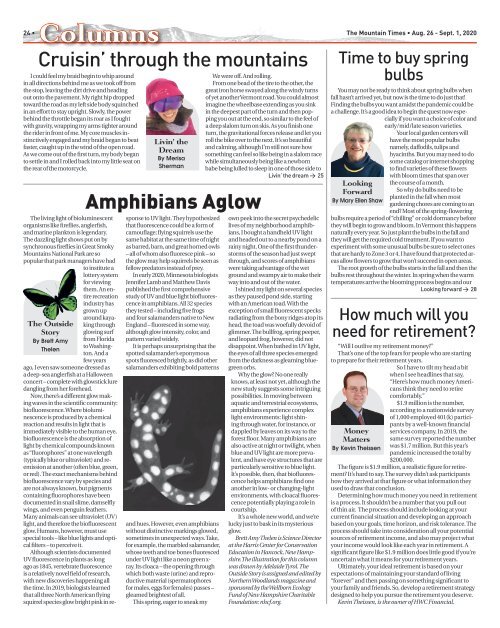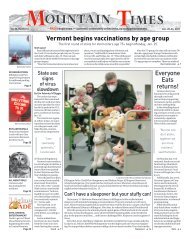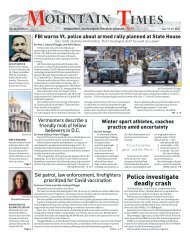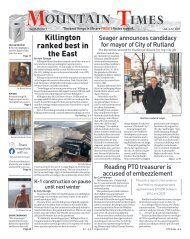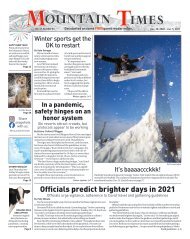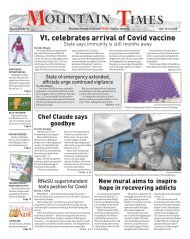Mountain Times - Volume 49, Number 35 - Aug.26-Sept.1, 2020
Create successful ePaper yourself
Turn your PDF publications into a flip-book with our unique Google optimized e-Paper software.
Columns<br />
24 • The <strong>Mountain</strong> <strong>Times</strong> • Aug. 26 - Sept. 1, <strong>2020</strong><br />
Cruisin’ through the mountains<br />
I could feel my braid begin to whip around<br />
in all directions behind me as we took off from<br />
the stop, leaving the dirt drive and heading<br />
out onto the pavement. My right hip dropped<br />
toward the road as my left side body squinched<br />
in an effort to stay upright. Slowly, the power<br />
behind the throttle began its roar as I fought<br />
with gravity, wrapping my arms tighter around<br />
the rider in front of me. My core muscles instinctively<br />
engaged and my braid began to beat<br />
faster, caught up in the wind of the open road.<br />
As we come out of the first turn, my body began<br />
to settle in and I rolled back into my little seat on<br />
the rear of the motorcycle.<br />
The living light of bioluminescent<br />
organisms like fireflies, anglerfish,<br />
and marine plankton is legendary.<br />
The dazzling light shows put on by<br />
synchronous fireflies in Great Smoky<br />
<strong>Mountain</strong>s National Park are so<br />
popular that park managers have had<br />
to institute a<br />
lottery system<br />
for viewing<br />
them. An entire<br />
recreation<br />
industry has<br />
grown up<br />
The Outside<br />
Story<br />
By Brett Amy<br />
Thelen<br />
around kayaking<br />
through<br />
glowing surf<br />
from Florida<br />
to Washington.<br />
And a<br />
few years<br />
Livin’ the<br />
Dream<br />
By Merisa<br />
Sherman<br />
Amphibians Aglow<br />
ago, I even saw someone dressed as<br />
a deep-sea anglerfish at a Halloween<br />
concert – complete with glowstick lure<br />
dangling from her forehead.<br />
Now, there’s a different glow making<br />
waves in the scientific community:<br />
biofluorescence. Where bioluminescence<br />
is produced by a chemical<br />
reaction and results in light that is<br />
immediately visible to the human eye,<br />
biofluorescence is the absorption of<br />
light by chemical compounds known<br />
as “fluorophores” at one wavelength<br />
(typically blue or ultraviolet) and reemission<br />
at another (often blue, green,<br />
or red). The exact mechanisms behind<br />
biofluorescence vary by species and<br />
are not always known, but pigments<br />
containing fluorophores have been<br />
documented in snail slime, damselfly<br />
wings, and even penguin feathers.<br />
Many animals can see ultraviolet (UV)<br />
light, and therefore the biofluorescent<br />
glow. Humans, however, must use<br />
special tools – like blue lights and optical<br />
filters – to perceive it.<br />
Although scientists documented<br />
UV fluorescence in plants as long<br />
ago as 1845, vertebrate fluorescence<br />
is a relatively novel field of research,<br />
with new discoveries happening all<br />
the time. In 2019, biologists learned<br />
that all three North American flying<br />
squirrel species glow bright pink in response<br />
to UV light. They hypothesized<br />
that fluorescence could be a form of<br />
camouflage; flying squirrels use the<br />
same habitat at the same time of night<br />
as barred, barn, and great horned owls<br />
– all of whom also fluoresce pink – so<br />
the glow may help squirrels be seen as<br />
fellow predators instead of prey.<br />
In early <strong>2020</strong>, Minnesota biologists<br />
Jennifer Lamb and Matthew Davis<br />
published the first comprehensive<br />
study of UV and blue light biofluorescence<br />
in amphibians. All 32 species<br />
they tested – including five frogs<br />
and four salamanders native to New<br />
England – fluoresced in some way,<br />
although glow intensity, color, and<br />
pattern varied widely.<br />
It is perhaps unsurprising that the<br />
spotted salamander’s eponymous<br />
spots fluoresced brightly, as did other<br />
salamanders exhibiting bold patterns<br />
and hues. However, even amphibians<br />
without distinctive markings glowed,<br />
sometimes in unexpected ways. Take,<br />
for example, the marbled salamander,<br />
whose teeth and toe bones fluoresced<br />
under UV light like a neon green x-<br />
ray. Its cloaca – the opening through<br />
which both waste (urine) and reproductive<br />
material (spermatophores<br />
for males, eggs for females) passes –<br />
gleamed brightest of all.<br />
This spring, eager to sneak my<br />
We were off. And rolling.<br />
From one bead of the tire to the other, the<br />
great iron horse swayed along the windy turns<br />
of yet another Vermont road. You could almost<br />
imagine the wheelbase extending as you sink<br />
in the deepest part of the turn and then popping<br />
you out at the end, so similar to the feel of<br />
a deep slalom turn on skis. As you finish one<br />
turn, the gravitational forces release and let you<br />
roll the bike over to the next. It’s so beautiful<br />
and calming, although I’m still not sure how<br />
something can feel so like being in a slalom race<br />
while simultaneously being like a newborn<br />
babe being lulled to sleep in one of those side to<br />
Livin’ the dream > 25<br />
own peek into the secret psychedelic<br />
lives of my neighborhood amphibians,<br />
I bought a handheld UV light<br />
and headed out to a nearby pond on a<br />
rainy night. One of the first thunderstorms<br />
of the season had just swept<br />
through, and scores of amphibians<br />
were taking advantage of the wet<br />
ground and swampy air to make their<br />
way into and out of the water.<br />
I shined my light on several species<br />
as they paused pond side, starting<br />
with an American toad. With the<br />
exception of small fluorescent specks<br />
radiating from the bony ridges atop its<br />
head, the toad was woefully devoid of<br />
glimmer. The bullfrog, spring peeper,<br />
and leopard frog, however, did not<br />
disappoint. When bathed in UV light,<br />
the eyes of all three species emerged<br />
from the darkness as gleaming bluegreen<br />
orbs.<br />
Why the glow? No one really<br />
knows, at least not yet, although the<br />
new study suggests some intriguing<br />
possibilities. In moving between<br />
aquatic and terrestrial ecosystems,<br />
amphibians experience complex<br />
light environments: light shining<br />
through water, for instance, or<br />
dappled by leaves on its way to the<br />
forest floor. Many amphibians are<br />
also active at night or twilight, when<br />
blue and UV light are more prevalent,<br />
and have eye structures that are<br />
particularly sensitive to blue light.<br />
It’s possible, then, that biofluorescence<br />
helps amphibians find one<br />
another in low- or changing-light<br />
environments, with cloacal fluorescence<br />
potentially playing a role in<br />
courtship.<br />
It’s a whole new world, and we’re<br />
lucky just to bask in its mysterious<br />
glow.<br />
Brett Amy Thelen is Science Director<br />
at the Harris Center for Conservation<br />
Education in Hancock, New Hampshire.The<br />
illustration for this column<br />
was drawn by Adelaide Tyrol. The<br />
Outside Story is assigned and edited by<br />
Northern Woodlands magazine and<br />
sponsored by the Wellborn Ecology<br />
Fund of New Hampshire Charitable<br />
Foundation: nhcf.org.<br />
Time to buy spring<br />
bulbs<br />
You may not be ready to think about spring bulbs when<br />
fall hasn’t arrived yet, but now is the time to do just that!<br />
Finding the bulbs you want amidst the pandemic could be<br />
a challenge. It’s a good idea to begin the quest now especially<br />
if you want a choice of color and<br />
early/mid/late season varieties.<br />
Your local garden centers will<br />
have the most popular bulbs<br />
namely, daffodils, tulips and<br />
hyacinths. But you may need to do<br />
some catalog or internet shopping<br />
to find varieties of these flowers<br />
with bloom times that span over<br />
Looking<br />
Forward<br />
By Mary Ellen Shaw<br />
the course of a month.<br />
So why do bulbs need to be<br />
planted in the fall when most<br />
gardening chores are coming to an<br />
end? Most of the spring-flowering<br />
bulbs require a period of “chilling” or cold dormancy before<br />
they will begin to grow and bloom. In Vermont this happens<br />
naturally every year. So just plant the bulbs in the fall and<br />
they will get the required cold treatment. If you want to<br />
experiment with some unusual bulbs be sure to select ones<br />
that are hardy to Zone 3 or 4. I have found that protected areas<br />
allow flowers to grow that won’t succeed in open areas.<br />
The root growth of the bulbs starts in the fall and then the<br />
bulbs rest throughout the winter. In spring when the warm<br />
temperatures arrive the blooming process begins and our<br />
How much will you<br />
need for retirement?<br />
Money<br />
Matters<br />
By Kevin Theissen<br />
Looking forward > 28<br />
“Will I outlive my retirement money?”<br />
That’s one of the top fears for people who are starting<br />
to prepare for their retirement years.<br />
So I have to tilt my head a bit<br />
when I see headlines that say,<br />
“Here’s how much money Americans<br />
think they need to retire<br />
comfortably.”<br />
$1.9 million is the number,<br />
according to a nationwide survey<br />
of 1,000 employed 401(k) participants<br />
by a well-known financial<br />
services company. In 2019, the<br />
same survey reported the number<br />
was $1.7 million. But this year’s<br />
pandemic increased the total by<br />
$200,000.<br />
The figure is $1.9 million, a realistic figure for retirement?<br />
It’s hard to say. The survey didn’t ask participants<br />
how they arrived at that figure or what information they<br />
used to draw that conclusion.<br />
Determining how much money you need in retirement<br />
is a process. It shouldn’t be a number that you pull out<br />
of thin air. The process should include looking at your<br />
current financial situation and developing an approach<br />
based on your goals, time horizon, and risk tolerance. The<br />
process should take into consideration all your potential<br />
sources of retirement income, and also may project what<br />
your income would look like each year in retirement. A<br />
significant figure like $1.9 million does little good if you’re<br />
uncertain what it means for your retirement years.<br />
Ultimately, your ideal retirement is based on your<br />
expectations of maintaining your standard of living<br />
“forever” and then passing on something significant to<br />
your family and friends. So, develop a retirement strategy<br />
designed to help you pursue the retirement you deserve.<br />
Kevin Theissen, is the owner of HWC Financial.


